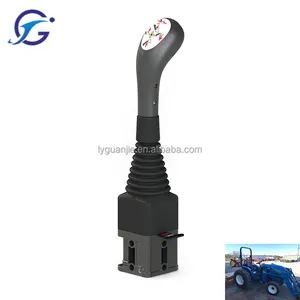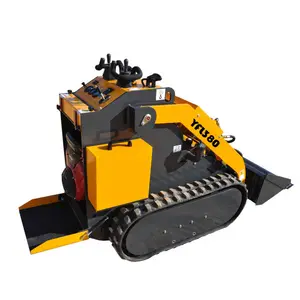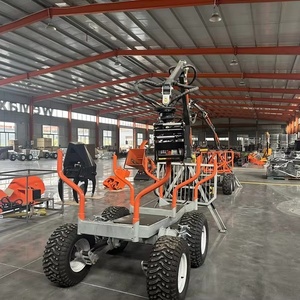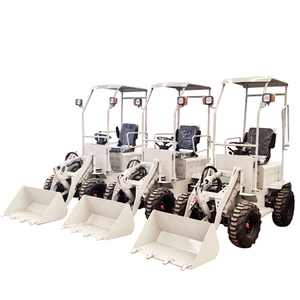Remote Control Loader Distributor

 CN
CN





 1/20
1/20








 1/24
1/24







 1/9
1/9







 1/13
1/13








 1/18
1/18





 1/18
1/18









 1/34
1/34








 1/9
1/9







 1/9
1/9









 1/19
1/19







 1/23
1/23





 1/9
1/9





 1/19
1/19
About remote control loader distributor
Where to Find Remote Control Loader Distributor Suppliers?
China remains the central hub for remote control loader manufacturing, with key production clusters in Shandong province driving innovation and export capacity. This region hosts vertically integrated facilities specializing in compact, electric, and diesel-powered tracked loaders equipped with wireless control systems. Suppliers benefit from proximity to steel, hydraulic component, and battery supply chains, reducing material procurement lead times by 20–30% compared to offshore alternatives.
The industrial ecosystem in Jining and Linyi supports rapid prototyping and scalable production, enabling suppliers to fulfill both small-batch trials and containerized orders efficiently. Most manufacturers operate under ISO 9001-aligned quality management frameworks, with growing adoption of CE certification for compliance in European and North American markets. Buyers gain access to a concentrated network of OEMs offering customization in load capacity (0.5–3 tons), power source (lithium-ion, lead-acid, diesel), and control system integration, all within a 50-km radius of major assembly plants.
How to Choose Remote Control Loader Distributor Suppliers?
Effective supplier selection requires systematic evaluation across technical, operational, and transactional dimensions:
Technical Compliance
Verify that suppliers provide documented adherence to CE standards for electrical and mechanical safety, particularly for wireless control modules and battery systems. For industrial applications, confirm compatibility with IP65-rated enclosures to ensure dust and moisture resistance. Request test reports for critical subsystems including motor endurance, remote signal stability, and hydraulic distributor performance under continuous load.
Production Capability Audits
Assess core manufacturing infrastructure through verifiable metrics:
- Minimum factory area exceeding 3,000m² to support dedicated welding, CNC machining, and final assembly lines
- In-house engineering teams capable of modifying bucket size, chassis width, and control interface layouts
- Monthly output capacity of at least 50 units to sustain bulk order fulfillment
- Integration of lithium-ion or diesel powertrains with remote telemetry systems
Cross-reference on-time delivery rates (target ≥85%) and response times (ideally ≤3 hours) as indicators of operational reliability.
Transaction Safeguards
Utilize secure payment mechanisms such as escrow services until equipment passes destination-based inspection. Prioritize suppliers with transparent revenue histories and verified dispute resolution records. Conduct sample testing to validate control range (typically 100–300 meters), load stability, and battery cycle life before scaling procurement.
What Are the Best Remote Control Loader Distributor Suppliers?
| Company Name | Location | Verified Manufacturer | Online Revenue | On-Time Delivery | Avg. Response | Reorder Rate | Customization Options | Main Product Focus |
|---|---|---|---|---|---|---|---|---|
| Shandong Songsheng Heavy Industry Machinery Co., Ltd. | Shandong, CN | Yes | US $130,000+ | 100% | ≤3h | <15% | Color, material, size, battery type, load capacity, logo, packaging | Electric mini loaders, tracked remote control loaders |
| Shandong Sonca Machinery Co., Ltd. | Shandong, CN | Yes | US $720,000+ | 100% | ≤2h | 15% | Color, material, size, bucket size, engine type, logo, packaging | 1–1.5 ton remote-controlled mini loaders |
| Ant Cloud Intelligent Equipment (Shandong) Co., Ltd. | Shandong, CN | Yes | US $420,000+ | 81% | ≤2h | 16% | Diesel, plug-in, color, material, size, lithium-ion, logo, packaging | Remote-control skid steer loaders, electric mini loaders |
| Linyi Million Heavy Industry Co., Ltd. | Shandong, CN | No | US $70,000+ | 66% | ≤2h | <15% | Limited customization reported | Compact tracked loaders, used machinery |
| Luoyang Guanjie Push-Pull Cable Controller Co., Ltd. | Henan, CN | No | US $20,000+ | 86% | ≤6h | <15% | Joystick controls, cable assemblies | Hydraulic distributors, control joysticks |
Performance Analysis
Shandong-based manufacturers dominate in scalability and customization depth. Shandong Sonca leads in online sales volume and perfect on-time delivery, indicating robust production planning. Ant Cloud Intelligent Equipment offers mid-range pricing ($2,000–$4,990) with strong support for lithium-ion electric models, though its 81% on-time rate suggests potential logistics bottlenecks. Luoyang Guanjie specializes in control components rather than full loader systems, making it suitable for spare parts sourcing. Linyi Million lists high-priced models ($35,000+) but exhibits lower delivery reliability (66%), warranting due diligence for large contracts. Buyers seeking fully customized, CE-compliant electric loaders should prioritize verified manufacturers with in-house R&D and documented quality control processes.
FAQs
How to verify remote control loader supplier reliability?
Confirm certifications (CE, ISO) through official registries and request factory audit reports. Evaluate responsiveness, order fulfillment history, and customer feedback focusing on post-delivery technical support and component durability.
What is the typical minimum order quantity (MOQ)?
Most suppliers set MOQ at 1 unit for remote control loaders, facilitating pilot testing. Component suppliers (e.g., joystick distributors) may require only 1 piece, enabling low-risk sampling.
What are common lead times for production and shipping?
Standard production lead time ranges from 20–35 days after order confirmation. Air freight delivery takes 7–10 days internationally; sea freight requires 25–40 days depending on destination port.
Do suppliers support custom branding and design?
Yes, verified manufacturers offer OEM services including custom logos, color schemes, packaging labels, and graphical interfaces. Lead time for customized prototypes is typically 3–4 weeks.
Are remote control loaders compatible with different battery types?
Many models support both lithium-ion and lead-acid battery configurations. Confirm voltage compatibility and charging infrastructure requirements when specifying power systems.



































































































